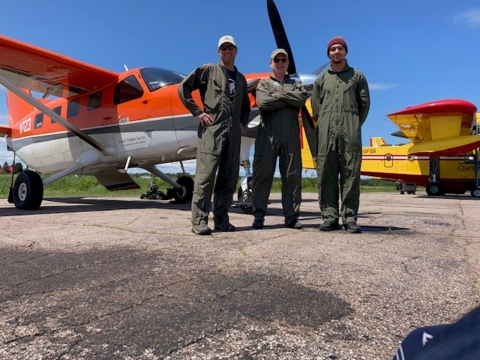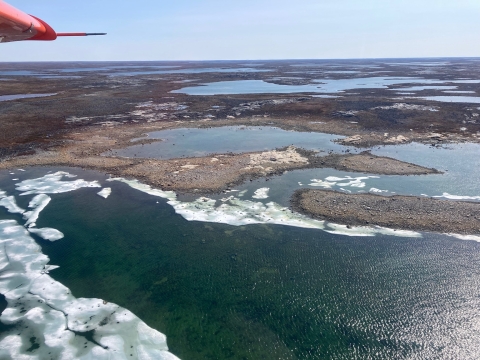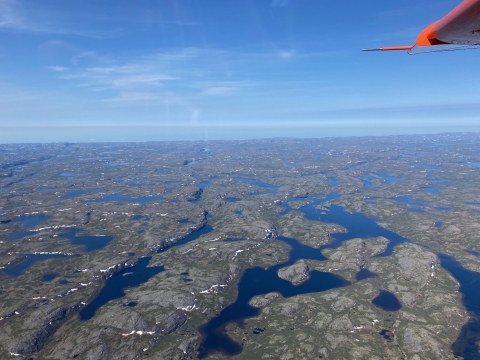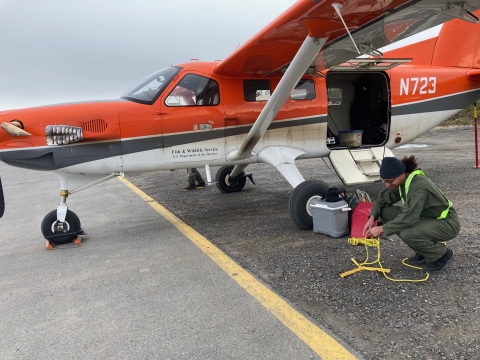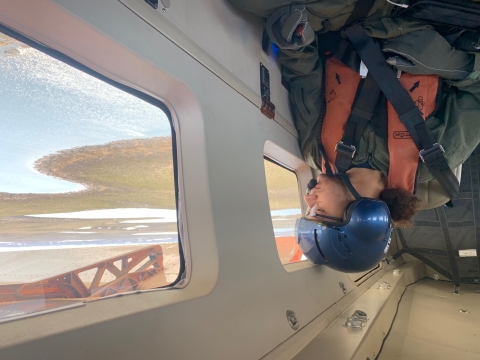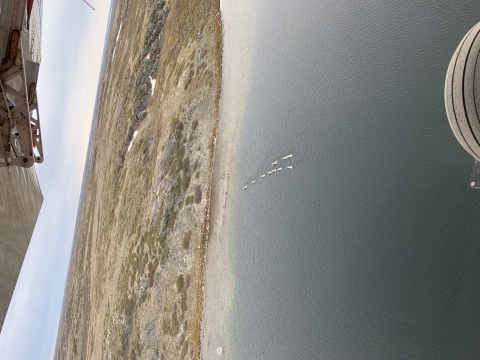During the 1960's, aerial surveys identified the Ungava Peninsula in northern Québec as the primary nesting area for Atlantic flyway Canada geese. Research found that the highest densities of geese were located along the coastal areas of Ungava Bay and Hudson Bay. In 1993, an annual survey was initiated to monitor the status of the Atlantic population by estimating the number of breeding pairs of Canada geese.
A Pilot’s Perspective by Rob Spangler
Greetings! We just returned from the Ungava Peninsula in northern Quebec after completing the Atlantic Population Canada Goose Survey. This survey is designed to inform biologists of current habitat conditions and population status to assist in the management of this population. I began my journey in Bangor, Maine on June 9th to pick up N723, our survey plane, and Andre Bergerson, a student volunteer from the Alaska Native Science and Engineering Program (ANSEP) before heading north. After filing a flight plan with the FAA and notifying the Canadian Border Services Agency of our arrival, we departed Bangor for Quebec City to pick up our Canadian Wildlife Service Biologist, Francis St-Pierre.
As we flew north to start the survey, signs of civilization became more and more distant. The roads and clear cuts disappear leaving us with a sense of peace and awe for this wonderful landscape of wilderness. As the miles clicked by, the habitat changed dramatically – shifting from a tall mixed-hardwood and coniferous forest to a landscape dominated by tundra with short dwarf birch, willow, and black spruce. When we arrived late in Kuujjuaq, the sun is still high in the sky, as we tie down the aircraft for the evening.
After our first flight the following day, we can already see that we timed the start of our survey perfectly based on the pairs of geese we saw. Francis flew in the right seat counting from his side of the aircraft and I counted from mine on the left. Andre sat behind me so I could train him in bird identification and counting as we flew at an altitude of around 200 ft and speed of 100 mph. There were definitely fewer birds (ducks and geese) on our first few transects than last year. Twenty years ago, the southern transects held more birds, but now there has been a shift in distribution to the north where densities of geese have increased in recent years. In response, we added a few extra transects on the north side of Hudson Bay to see if geese were present in appreciable numbers north of our historic survey area. These new northern transects held moderate densities of geese so adding them to our survey effort in the future will need to be considered. However, we observed the highest densities of geese in the vicinity of Purvirnituq, located on the Hudson Bay side of the Ungava Peninsula.
We had a great survey this year with a stellar crew and great flying weather. In 2018 we spent 8 straight days in Kuujjuaq waiting out snow and freezing rain and it was the longest survey on record due to weather delays. This year I think we set the record for the shortest survey as we had only one weather day. So… it was fly, fly, fly, and then catch up on everything else later. We have not analyzed the data yet, but at least we did observe a fair number of “singles” which indicates that the females were nesting. Females hide on the nest and the males are often more conspicuous. On this survey, we also counted caribou and muskoxen while we are on our goose transects. It does not cost any more to do so and there are very few survey efforts in this part of the world. Therefore, even presence/absence data is valuable. The caribou population is still very low after the population crash over 20 years ago, but we do see them and occasionally and even some with a few young. We also observed muskoxen which have spread across northern Quebec, but in low numbers. Well, that’s it for now. Talk to you on our next survey!
Learning the Ropes: by Andre Bergerson
Hi, my name is Andre Bergerson, and as an aviation enthusiast and outdoor admirer, this internship with the Migratory Bird Program allowed me to combine my love for flying with my dedication to protecting our natural world. Early in my education, I discovered ANSEP (Alaska Native Science and Engineering Program) which focuses on accelerated learning for students interested in careers in Science Technology Engineering and Math. ANSEP partners with many government and non-government organizations to provide the chance for students to explore careers that match their interests. They connected me with this unique opportunity to participate in an aerial survey that supports the conservation of migratory birds.
During my internship, I embarked on a breathtaking journey across the Canadian tundra. While conducting the survey, our team of three stayed in small native villages nestled within the rugged beauty of Nunavut, northern Quebec. My duties consisted of tying down and securing the aircraft and flying as an observer in a Quest Kodiak aircraft to count birds. Our main focus was the Atlantic population of Canada geese, but we also had the responsibility of counting other bird species such a as common eiders, black scoters, black ducks, and scaup. The purpose of our survey was to gather critical data to assist in the development of hunting regulations for the protection and conservation of this migratory goose population in both the United States and Canada.
The opportunity to conduct aerial surveys provided me with a unique perspective on the significance of preserving our migratory bird populations and highlighted a career I never thought possible. Not only did I gain invaluable insights into aviation techniques, such as flight planning and risk management, but I also developed an understanding of the complexities surrounding the implementation of the Migratory Bird Treaty Act. The work we conducted during this survey serves as a testament to the importance of collaboration, data-driven decision making, and the need to safeguard the delicate balance between human activities and the natural world.


